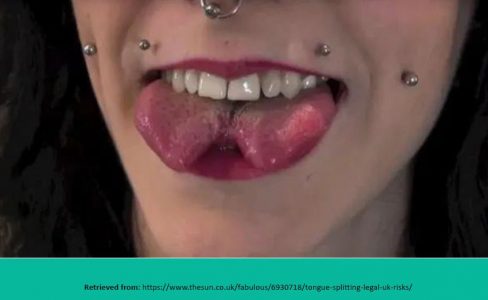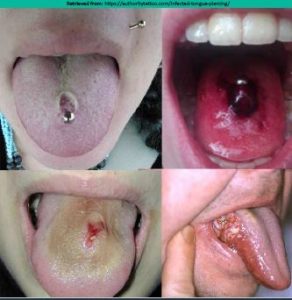Background and Objectives
• Were previously considered taboo, but there has been an increase in popularity in today’s society.
• Recent rise in alternative modifications, such as, tongue splitting, subdermal implants, and transdermal implants.
• Significant role in individuals culture; others are done for personal preference, or self-expression.
• Inform health care providers about various peri-oral modifications and the implications to oral/overall health.
• Discuss the oral care challenges.
• Explain and discuss the findings associated with modifications and the impact on treatment.
• Discuss evidence based research practices.

Research
• Finding credible information was difficult.
• Very little research has been conducted on the topic.
• There are numerous head and neck modifications, all with various amounts of information available.
• Information provided by dental regulatory authorities
(American Dental Association) and the Canadian Government were credible sources of information.
• Clinical guidelines outlined by the College of Dental Hygienists of Ontario regarding oral piercings and their care, published in (2015) was a main source of credible information.
• Sources of information older than five years were used when the information was found to be relevant.

Conclusions
• Remain unbiased when providing treatment.
• Knowledge of modifications is necessary: to educate clients in complications, self-care and maintenance.
• Associated with oral and overall health risks.
• Challenges to oral care for the individual and oral health care professional.
• Be aware of the findings associated with modifications and the impact on treatment .
• Stay current on trends and evidence-based practices
• Recommend clients do not undergo any modification procedures.
• Provide individualized client-centered care.
• Educate clients on self-care, signs and symptoms of complications and when to seek professional care or emergency medical treatment.
• Collaborate with clients and health care professionals to ensure client health and safety.
American Dental Association. (2019, March 27). Oral health topics. Retrieved November 19, 2019 from https://www.ada.org/en/member-center/oral-health-topics/oral-piercing British Columbia Ministry of Health. Health Protection Branch (2017). Guidelines for body modification. Retrieved from https://www2.gov.bc.ca/assets/gov/health/keeping-bc- healthy-safe/pses/body_modification_guidelines_nov_2017.pdf College of Dental Hygienists of Ontario. (2015). Oral piercing. Retrieved from http://www.cdho.org/Advisories/CDHO_Factsheet_Oral_Piercing.pdf Barnes, D. (2010). Dental modification: An anthropological perspective (Honors thesis). Retrieved from https://trace.tennessee.edu/utk_chanhonoproj/1345 Healthwise Staff. (2017). Body piercing problems. Retrieved October 27, 2019 from https://www.healthlinkbc.ca/health-topics/hw250805#hw250969

